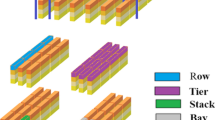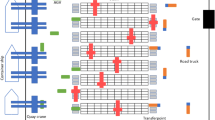Abstract
A solution to the problems of resource allocation and scheduling of loading and unloading operations in a container terminal is presented. The two problems are formulated and solved hierarchically. First, the solution of the resource allocation problem returns, over a number of work shifts, a set of quay cranes used to load and unload containers from the moored ships and the set of yard cranes to store those containers on the yard. Then, a scheduling problem is formulated to compute the loading and unloading lists of containers for each allocated crane. The feasibility of the solution is verified against a detailed, discrete-event based, simulation model of the terminal. The simulation results show that the optimized resource allocation, which reduces the costs by [frac13], can be effectively adopted in combination with the optimized loading and unloading list. Moreover, the simulation shows that the optimized lists reduce the number of crane conflicts on the yard and the average length of the truck queues in the terminal.
Similar content being viewed by others
References
Aarts, E. H. and Lenstra, J. K. (1997) Introduction. Local Search in Combinatorial Optimization, John Wiley & Sons, Chichester, pp. 1-17.
Ahuja, R., Magnanti, T. and Orlin, J. (1993) Network Flows, Prentice Hall, New Jersey.
Booch, G. (1994) Object-oriented Analysis and Design: with Applications, 2nd edn, Rational, Santa Clara.
CACI Products Company (1996) Modsim III, the Language for Object-oriented Programming. User's Manual, La Jolla, CA.
Gambardella, L. M., Rizzoli, A. E. and Zaffalon, M. (1998) Simulation and planning of an intermodal container terminal. Simulation, 71, 107-116.
Erard, P.-J. and Déguénon, P. (1996) Simulation par éveénements discrets, Lausanne Presses Polytechniques et Universitaires Romandes.
Garey, M. R., Johnson, D. S. and Sethi, R. (1976) The complexity of flowshop and jobshop scheduling. Mathematical Operators Research, 1, 117-129.
Glover, F. (1989) Tabu search—Part I. ORSA Journal on Computing, 1, 190-206.
Hayuth, Y., Pollatschek, M. A. and Roll, Y. (1994) Building a port simulator. Simulation, 63, 179-189.
Hog (1998) Cplex 6, www.ilog.com.
Kozan, E. and Preston, P. (1999) Genetic algorithms to schedule container transfers at multimodal terminals. International Transactions in Operational Research, 6, 311-329.
Kim, H. K. and Bae K. H. (1999) Segregating space allocation models for container inventories in port container terminals. International Journal of Production Economics, 59, 415-423.
Kim, H. K. and Kim Y. K. (1999) Routing straddle carriers for the loading operation of containers using a beam search algorithm. Computers and Industrial Engineering, 36, 109-136.
Magnanti, T. L. and Wong, R. T. (1984) Network design and transportation planning: models and algorithms. Transportation Science, 18, 1-56.
Mastrolilli, M. and Gambardella, L. M. (2000) Effective neighborhood functions for the flexible job shop problem. Journal of Scheduling, 3, 3-20.
Papadimitriou, H. and Steiglitz, K. (1982) Combinatorial Optimization: Algorithms and Complexity, Prentice Hall, New York.
Sha, O. P. (1985) Computer aided on board management. Computer Applications in the Automation of Shipyard Operation and Ship Design V, P. Banda, C. Kuo, (eds), Elsevier, Amsterdam, pp. 177-187.
Young, Y. W. and Seok, C. Y. (1999) A simulation model for container-terminal operation analysis using an object-oriented approach. International Journal of Production Economics, 59, 221-230.
Zaffalon, M. and Gambardella, L. M. (1998) Optimization of resources in an intermodal terminal, IDSIA Technical Report n. IDSIA-20-98.
Zeigler, B. P. (1984) Mutifacetted Modelling and Discrete Event Simulation, Academic Press.
Zeigler, B. P. (1990) Object-oriented Simulation with Hierarchial Modular Models: Intelligent Agents and Endomorphic Systems, Academic Press.
Author information
Authors and Affiliations
Rights and permissions
About this article
Cite this article
Gambardella, L.M., Mastrolilli, M., Rizzoli, A.E. et al. An optimization methodology for intermodal terminal management. Journal of Intelligent Manufacturing 12, 521–534 (2001). https://doi.org/10.1023/A:1012208605758
Issue Date:
DOI: https://doi.org/10.1023/A:1012208605758




